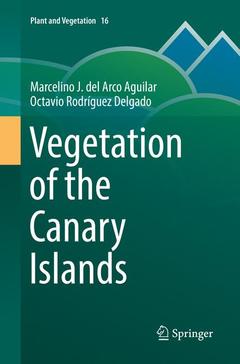Description
Vegetation of the Canary Islands, Softcover reprint of the original 1st ed. 2018
Plant and Vegetation Series, Vol. 16
Authors: del Arco Aguilar Marcelino J., Rodríguez Delgado Octavio
Language: English
Subjects for Vegetation of the Canary Islands:
179.34 €
In Print (Delivery period: 15 days).
Add to cartPublication date: 12-2018
Support: Print on demand
179.34 €
In Print (Delivery period: 15 days).
Add to cartPublication date: 08-2018
Support: Print on demand
Description
/li>Contents
/li>Comment
/li>
The volcanic and oceanic nature of the Canary Islands, its rich plant biodiversity and high rate of endemism, as well as the relict character of some of its plant communities make it a territory of great biological interest.
The main geographic, climatic, bioclimatic, biogeographic and floristic features of the Islands are shown and related to the distributional pattern of potential communities along an altitudinal gradient. Current vegetation units and their ecology are described and illustrated with numerous pictures. Potential vegetation units are summarized and comprehensive maps of the potential natural vegetation for each island are given.
Human impact on the natural landscape, the occurrence of invasive plants, and the probable impact of climate change on the flora and vegetation are discussed. The conservation status of flora and vegetation are assessed.
Four appendixes include a syntaxonomical scheme, a brief history of botanical studies and explorations in the Islands, ethnobotanical notes, and a list of selected literature.
1. Introduction.- 2. Geographic framework.- 3. Climate. 3.1. Anticyclonic Weather.- 3.2. Saharan Weather.- 3.3. Disturbed Weather.- 4. Bioclimate.- 4.1. Bioclimatic Belts.- 4.2. Bioclimatic Belts in the Canary Islands.- 4.3. Bioclimographs.- 5. Biogeography.- 5.1. Colonization.- 5.2. Biogeographic Classification.- 6. Other Floristic Considerations.- 6.1. Non-Vascular Flora.- 6.2. Vascular Flora.- 7. Vegetation of the Canary Islands.- 7.1. An Overview.- 7.2. Current Vegetation.- 7.3. Potential Natural Vegetation.- 7.4. Characteristic Species of the Most Representative Classes of the Climatophilous Vegetation.- 8. Change in the Natural Landscape Through Human Influence.- 8.1. Uses and Degradation of the Plant Cover by the Aboriginal Population.- 8.2. The Intense Landscape Disturbance and Transformation after the Conquest.- 8.3. Current Climate Change.- 9. Conservation Status of Flora and Vegetation.- 9.1. Protection of Natural Reserves.- 9.2. Botanical Gardens, Seed and Germoplasm Banks and Nurseries.- 9.3. Invasive Plants.- Appendix 1.- Appendix 2.- Appendix 3.- Appendix 4.- Index.
Describes and richly illustrates the plant communities of the Canary Islands for an international audience
Discusses the plant communities in a coherent biogeographical and bioclimatic framework of the Canary-Madeiran subregion within the Mediterranean macrobioclimatic Region
Emphasizes the floristic and phytocenotic variety of the islands which are a biodiversity hot-spot
Constitutes a didactic manual that presently does not exist in the market
These books may interest you

Vegetation Ecology of Socotra 210.99 €

Vegetation Ecology of Socotra 210.99 €


